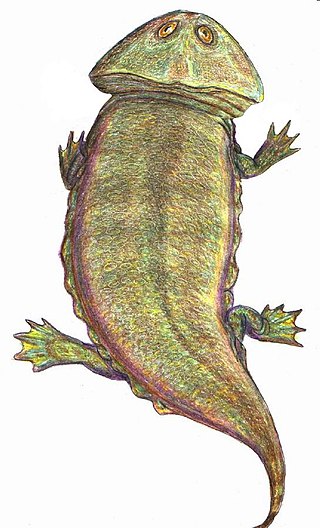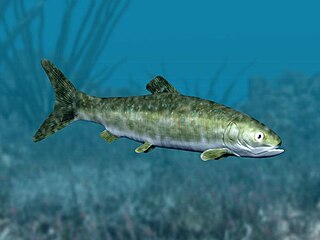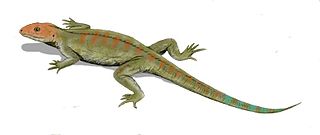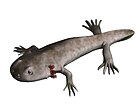Related Research Articles

Hylonomus is an extinct genus of reptile that lived 312 million years ago during the Late Carboniferous period. It is the earliest unquestionable reptile. The only species is the type species Hylonomus lyelli. Despite being amongst the oldest known reptiles, it is not the most primitive member of group, being a eureptile more derived than either parareptiles or captorhinids.

Sir Arthur Smith Woodward, FRS was an English palaeontologist, known as a world expert in fossil fish. He also described the Piltdown Man fossils, which were later determined to be fraudulent. He is not related to Henry Woodward, whom he replaced as curator of the Geology Department of the British Museum of Natural History.

Archaeothyris is an extinct genus of ophiacodontid synapsid that lived during the Late Carboniferous and is known from Nova Scotia. Dated to 306 million years ago, Archaeothyris, along with a more poorly known synapsid called Echinerpeton, are the oldest undisputed synapsids known. The name means ancient window (Greek), and refers to the opening in the skull, the temporal fenestra, which indicates this is an early synapsid. Protoclepsydrops also from Nova Scotia is slightly older but is known by very fragmentary materials.

Aphaneramma is an extinct genus of marine temnospondyl amphibian. It lived during the Early Triassic epoch, approximately 252–247 Ma ago, and had a global distribution.
David Woodward was an English-born American historian of cartography and cartographer.
Leptodactylodon wildi is a species of frogs in the family Arthroleptidae.

Plagiosaurus is an extinct genus of temnospondyl amphibian - Arthur Smith Woodward regarded it as a synonym of Plagiosternum. They were paedomorphic, retaining the larval gills on adulthood. They had weak simplified vertebrae, consisting of large intercentra and neural arches, the stereospondyl condition.

Batropetes is an extinct genus of brachystelechid recumbirostran "microsaur". Batropetes lived during the Sakmarian stage of the Early Permian. Fossils attributable to the type species B. fritschi have been collected from the town of Freital in Saxony, Germany, near the city of Dresden. Additional material has been found from the Saar-Nahe Basin in southwestern Germany and has been assigned to three additional species: B. niederkirchensis, B. palatinus, and B. appelensis.
Rhinesuchoides is an extinct genus of prehistoric temnospondyl in the family Rhinesuchidae. It contains two species, R. tenuiceps and R. capensis, both from the Karoo Supergroup of South Africa. The latter was formerly a species of Rhinesuchus.
Aetheolepis is an extinct genus of ray-finned fish which lived in freshwater environments in what is now Western Australia and New South Wales during the Jurassic period. It contains one species, A. mirabilis. Aetheolepis was previously thought to be an archaeomaenid, until a 2016 study instead recovered it as a member of the family Dapediidae. Like other dapediids, it had a deep, discoid-shaped body. Fossils of A. mirabilis have been found in the Talbragar River fossil beds of New South Wales and the Colalura Sandstone of Western Australia. It was named by Arthur Smith Woodward in 1865 along with other Talbragar fish.
Wardichthys is an extinct genus of prehistoric bony fish that lived during the Tournaisian stage of the Mississippian epoch.
Sassenia is an extinct genus of prehistoric coelacanth lobe-finned fish that lived during the Early Triassic epoch in what is now East Greenland and Svalbard.
Coccocephalichthys is an extinct genus of prehistoric bony fish from the Carboniferous period. The type species, C. wildi, lived during the Bashkirian age of the Pennsylvanian epoch in what is now Lancashire, United Kingdom.
Urosthenes is an extinct genus of prehistoric bony fish that lived during the Lopingian to Middle Triassic epochs in what is now New South Wales, Australia.

Ichthyokentema ("fish-goad") is an extinct genus of stem-teleost fish that lived during the Late Jurassic. It contains one species, I. purbeckensis, which is known from the Purbeck Group of Dorset, England. I. purbeckensis was originally described as a species of Pholidophorus by William Davies in 1887, but was moved to its own genus by Arthur Smith Woodward in 1941.

Oweniasuchus is an extinct genus of goniopholidid mesoeucrocodylian. Remains have been found from England and Portugal that are Cretaceous in age.
Tatrasuchus is an extinct genus of temnospondyl amphibian from the Middle Triassic of Poland. It is classified as a member of the family Cyclotosauridae or Mastodonsauridae. It is closely related to the genus Cyclotosaurus. The type species, Tatrasuchus kulczyckii, was named in 1996. Damiani (2001) considered genus Kupferzellia Schoch (1997) from Middle Triassic of Germany to be a junior synonym of Tatrasuchus, and recombined its type species, K. wildi as the second species of Tatrasuchus. This classification was followed by some authors, e.g. Fortuny et al. (2011); other authors, e.g. Schoch (2008), maintain Tatrasuchus and Kupferzellia as distinct genera.
Kashmirosaurus is an extinct genus of temnospondyl amphibian known from Permo-Carboniferous deposits in the region of Kashmir. It was originally named by English paleontologist Arthur Smith Woodward in 1905 as a species of Archegosaurus called Archegosaurus ornatus. More recently, the species has been recognized as being distinct from Archegosaurus, and it was placed in its own genus Kashmirosaurus in 1996. An additional species of Archegosaurus, A. kashmiriensis, was named in 1960 from the same deposits in Kashmir, and is now considered synonymous with Kashmirosaurus ornatus.

The Tensleep Sandstone is a geological formation of Pennsylvanian to very early Permian age in Wyoming.

Steganoposaurus is an ichnogenus of fossil reptile footprints. The ichnospecies Steganoposaurus belli, was erected for footprints discovered in Wyoming's Tensleep Sandstone. The find was first reported to the scientific literature by Edward Branson and Maurice Mehl in 1932. This creature was originally presumed to be an amphibian, but the toe prints it left behind were pointed like a reptile's rather than round like an amphibians. The actual trackmaker may have been similar to the genus Hylonomus. The ichnogenus Tridentichnus are similar footprints preserved in the Supai Formation of Arizona.
References
- ↑ Woodward, Arthur Smith (2009). "VI.—On a Microsaurian ( Hylonomus Wildi, sp. Nov.) from the Lancashire Coal-field". Geological Magazine. 8 (5): 211–213. doi:10.1017/S0016756800187862.













